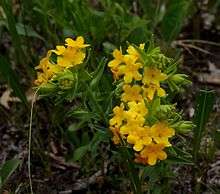Lithospermum caroliniense
| Lithospermum caroliniense | |
|---|---|
 | |
| Scientific classification | |
| Kingdom: | Plantae |
| (unranked): | Angiosperms |
| (unranked): | Eudicots |
| (unranked): | Asterids |
| Order: | (unplaced) |
| Family: | Boraginaceae |
| Genus: | Lithospermum |
| Species: | L. caroliniense |
| Binomial name | |
| Lithospermum caroliniense (Walter ex J.F. Gmel.) MacMill. | |
Lithospermum caroliniense is commonly known as the hairy puccoon or Carolina puccoon. It is found in the United States in the Midwest, around the Great Lakes, and through the Canadian provinces surrounding the Great Lakes.[1] The plant grows in sandhills, pine barrens and dry, sandy woods.[2]
Dr. Robert W. Poole and Dr. Patricia Gentili at the website nearctica describe the Hairy puccoon as follows:
Flowers large (up to 1 inch in diameter) yellow-orange with 5 petals and basal parts of petals fused into a long corolla tube. Stamens hidden in corolla tube. Flowers arranged in a flat-topped cluster or weakly curled, short sprays. Stem and leaves coarsely hairy. Leaves broadest in the middle, tapering at either end, and outer margin smooth. Plant 1 to 2.5 feet in height.[3]
Cultivation and uses
To cultivate Lithospermum caroliniense a warm sunny position in a moderately fertile well-drained lime-free sandy soil is needed.
A red dye is obtained from the dried or pulverized roots. The powdered root has also been used in the treatment of chest wounds.[2]